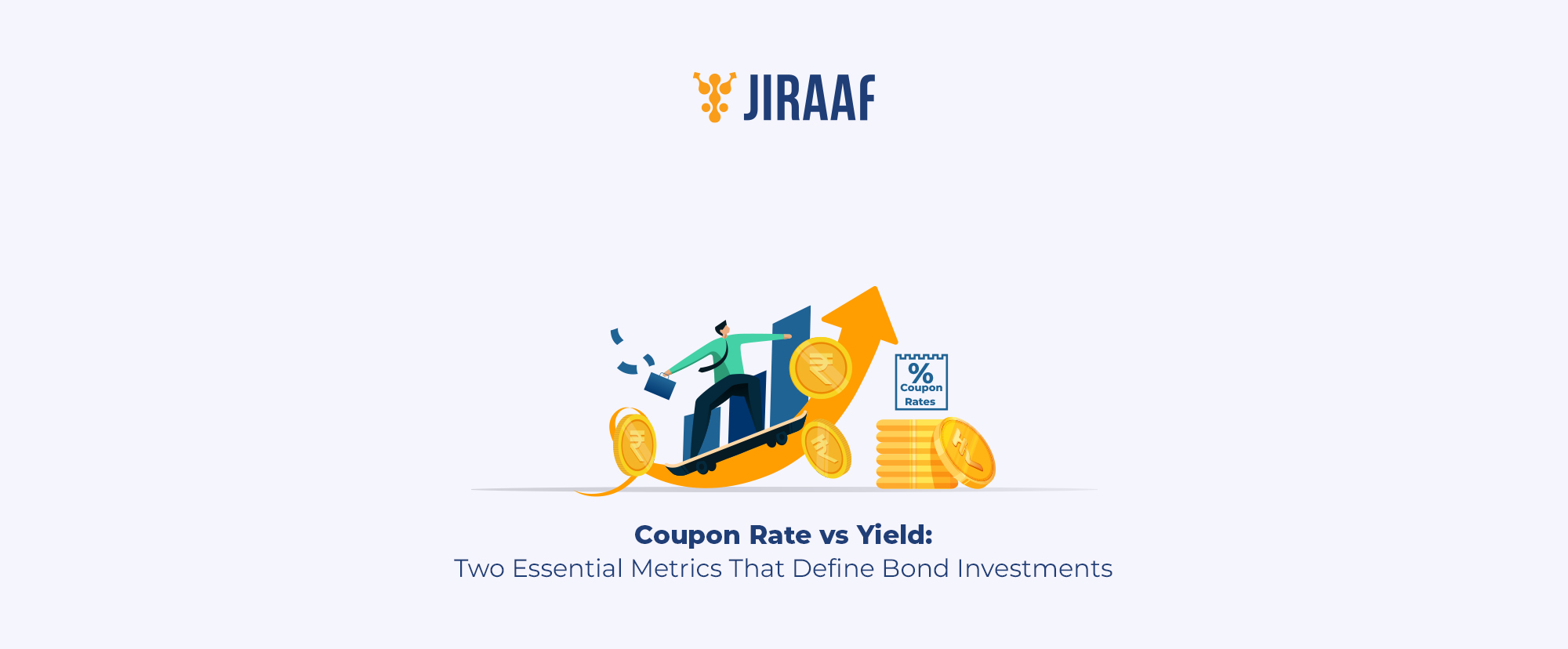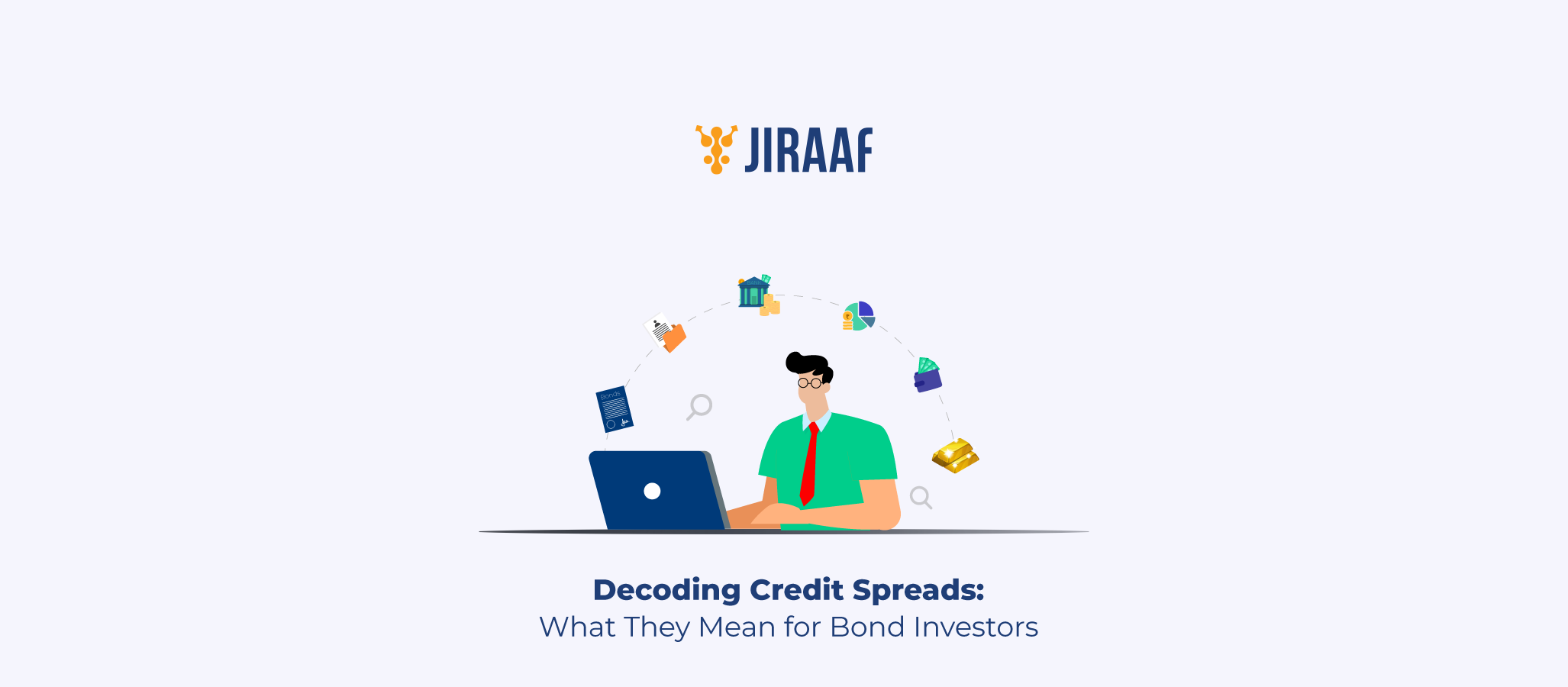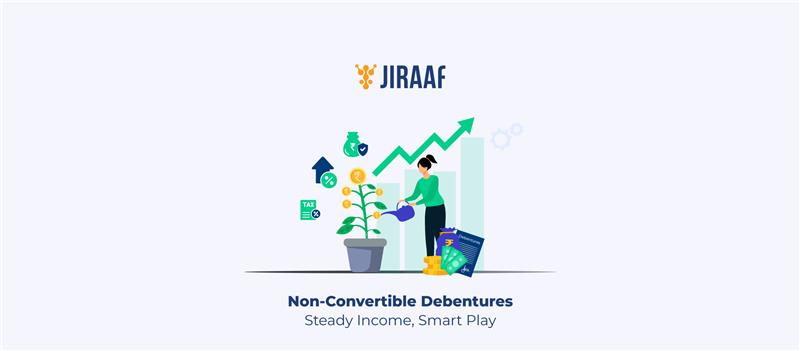Have you wondered why a bond’s yield sometimes exceeds its coupon rate or how rate changes affect returns? These aren’t just theoretical questions—they directly impact your investment outcomes. In a market where fluctuating interest rates shape bond valuations, understanding metrics like coupon rate and yield is critical.
Knowing the difference between bond yield and coupon rate equips investors to make strategic choices, revealing how capital market dynamics influence returns and the overall appeal of a bond.
Whether you’re navigating rate changes or planning long-term, this blog offers actionable insights to strengthen your portfolio.
What is a Coupon Rate?
The coupon rate represents the bond issuer’s commitment to pay investors a predetermined fixed interest percentage of its value, irrespective of market conditions.
The coupon rate is set at the time of issuance and remains unchanged throughout the bond’s life, regardless of market price fluctuations.
Calculating coupon rate:
Coupon Rate = (Annual Coupon Payment/Face Value) × 100
For example, a bond with an annual coupon payment of ₹2,000 and a face value of ₹40,000 has a coupon rate of 5%.
While the coupon rate is an essential measure of a bond’s income potential, it does not provide a complete picture of its return. That’s where the concept of yield becomes vital.
What is Yield or Bond Yield?
The bond yield represents the actual return an investor earns on a bond, considering its current market price. Unlike the fixed coupon rate, yield fluctuates with market conditions, providing a dynamic measure of a bond’s performance.
Example: A bond with a face value of ₹1,00,000 and a 5% coupon rate offers ₹5,000 yield annually. If its market price drops to ₹95,000, the current yield rises to:
(₹5,000/₹95,000) ×100 = 5.26%
Yield also takes a longer-term perspective through yield-to-maturity (YTM), which includes all coupon payments and any capital gain or loss if held until maturity.
In essence, bond yield answers the question, “What is the true return I’m earning on my investment?” by helping investors understand the bond’s performance comprehensively.
Key Differences Between Coupon Rate and Yield in Bonds
Analyzing the difference between coupon rate and yield is critical to assessing bond performance
| Aspect | Coupon Rate | Yield |
| Definition | It is a fixed annual interest as a % of the bond’s face value | It is the actual return based on the market price |
| Fixed or Variable | It is fixed throughout the bond’s term | It varies with market conditions |
| Market Dependency | It is independent of bond price | It changes with bond price fluctuations |
| Calculation Basis | Calculated on face value | Calculated on the market price |
Factors Affecting Coupon Rate and Yield
The interplay between coupon rate and yield is influenced by several interconnected factors. Understanding these drivers not only sheds light on their relationship but can also help you anticipate how a bond’s value and returns may evolve over time.
1. Market Interest Rates
When interest rates rise, existing bonds with lower coupon rates become less attractive, leading to a drop in their market price. This decline increases the bond’s yield, as the same fixed coupon payment is now spread over a reduced price. Conversely, when interest rates fall, the bond price increases, pushing the yield down.
2. Creditworthiness of the Issuer
Bonds issued by entities with strong credit ratings typically offer lower coupon rates, reflecting their reduced risk of default. However, if an issuer’s creditworthiness deteriorates, investors demand higher yields to compensate for the added risk, causing the bond’s market price to drop.
3. Bond Maturity and Time to Maturity
The relationship between coupon rate and yield also depends on the bond’s remaining time to maturity. Long-term bonds tend to be more sensitive to changes in market interest rates, often exhibiting larger price fluctuations. This volatility affects the bond’s yield more significantly than shorter-term bonds.
The Yield and Coupon Rate Relationship in Context
These factors often interact in complex ways. For instance, a bond’s yield may rise not only due to an increase in interest rates but also because of declining issuer creditworthiness.
Similarly, economic conditions like inflation or market uncertainty can amplify these dynamics, influencing investor demand and, by extension, the bond’s price and yield.
Noteworthy Considerations:
What Does It Mean If the Yield Is Higher Than the Coupon Rate of a Bond and Vice-versa?
If the yield is higher than the coupon rate, it indicates the bond is trading at a discount. Conversely, a yield lower than the coupon rate signifies a premium bond.
What is the Difference Between Coupon Rate and Interest Rate?
While the coupon rate is the fixed return on the bond’s face value, the interest rate refers to the broader market rate influencing bond prices and yields.
What is the Difference Between Coupon Rate and YTM?
The coupon rate reflects fixed interest rate payments of the bond, while YTM accounts for the bond’s total returns, including price changes, making it a more comprehensive metric.
Why Understanding Coupon Rate and Yield Matters for Investors
Grasping the relationship between yield and coupon rate is important to make well-informed choices. Here’s why:
- Portfolio Optimization: Knowing the difference between bond yield and coupon rate helps align bond purchases with your income and investment goals
- Bond Attractiveness Assessment: Bonds that offer comparatively higher yields can signal greater risk, while premium bonds might offer stability despite lower yields
- Market Trend Adaptation: Understanding bond metrics allows you to respond effectively to changes in interest rates and market sentiment
Practical Example:
Consider two bonds: one with a high coupon rate and another with a low coupon rate but higher yield. Depending on your risk tolerance, you can decide which fits your strategy — whether prioritizing income or capital appreciation.
Concluding Thoughts
Navigating the bond market becomes significantly easier when you comprehend the nuances of factors like coupon rate and yield. While one offers a static measure of income, the other provides dynamic insights based on market realities.
As an investor, leveraging these metrics can enhance your portfolio’s resilience and performance. Stay informed, adapt to market conditions, and ensure your bond investments align with your broader financial goals. With this knowledge, you’re better equipped to maximize returns and mitigate risks.
FAQs About Coupon Rate and Yield
What is the Relationship Between Coupon Rate and Yield?
The coupon rate is the fixed interest you earn based on a bond’s face value, while the yield shows your actual return, influenced by the bond’s current market price. As bond prices fluctuate, yield adjusts, offering a clearer picture of your investment’s performance.
Can the Yield of a Bond Be Higher Than its Coupon Rate?
Yes, if a bond is bought at a discount (below face value), its yield can exceed the coupon rate. This happens because the fixed interest payment is spread over a smaller price, increasing your return.
Is it Better to Invest in Bonds with a High Coupon Rate or High Yield?
It depends on your goals. Bonds with a high coupon rate offer stable income, while those with a high yield may provide higher returns but with more risk. Choose bonds based on whether you prefer steady cash flow or potential capital gains.
Discover fixed income investments with Jiraaf, a SEBI registered online bonds platform that educates and brings access to a wide array of bonds. Sign up today to explore diversified fixed income investment opportunities to support your goal-based wealth creation journey. Start investing!




